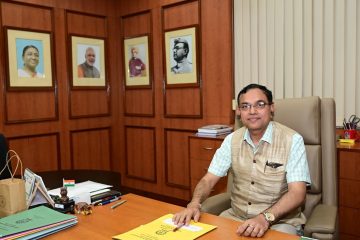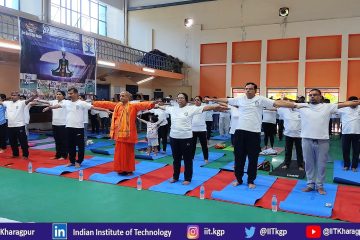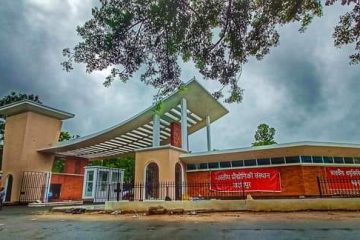The Ministry of Education kick-started the 3rd phase of Yuva Sangam starting from 21st to 30th November, 2023 with a delegation of 50 students belonging to diverse parts of Madhya Pradesh travelling to West Bengal for a cultural and education tour. A nation-wide Student Exchange Programme, as we say might say it, Yuva Sangam under the Ek Bharat Shreshtha Bharat initiative endeavours to promote experiential learning and introduces the youth of the country to the rich diversity of our country. It also aims to provide an immersive experience into the unique facets of life, developed landmarks, architectural and engineering marvels, industrial progress and recent achievements in the host state with the focus being on people-to-people connect.

As part of the ongoing phase of Yuva Sangam, exposure tours were conducted throughout November and December 2023 wherein youth comprising mainly of students studying in Higher Educational institutions (HEIs) as also off-campus youngsters in the age group 18-30 years from across the nation traveled to their paired states. Phase 3 witnessed immense vigour and enthusiasm among the participants. This phase takes forth the idea behind this unique initiative under the aegis of Ek Bharat Shreshtha Bharat by the Government of India which intends to not just expand the intellectual horizons of young agents of change but to also sensitizes them to diversity across India so as to channelize their knowledge for a more connected, empathetic and technologically robust India of the future. An initiative by Government of India to strengthen people-to-people connect especially between youth belonging to North Eastern India and other States. Yuva Sangam of Ek Bharat Shreshtha Bharat focuses on conducting exposure tours for the youth and provide an immersive experience of various facets of life, development landmarks, recent achievements and youth connect in the host state. During their visits, the youth had a multi-dimensional exposure under five broad areas – Paryatan (Tourism), Parampara (Traditions), Pragati (Development), Prodyogik (Technology) and ParasparSampark (People-to-people connect).
Yuva Sangam Phase-III had participation from 22 States and UTs with the following Higher Education Institutions paired for the purpose of conducting the exposure tours: Central Tribal University of Andhra Pradesh-IIT Delhi; IIT Dharwad-IIT Ropar; SPPU Pune-IIT Guwahati; IIT Hyderabad-BHU Varanasi; IIM Trichy-IIIT Kota; IIM Sambalpur-NIT Calicut; IIITDM Jabalpur-IIT Kharagpur; IIIT Ranchi-NIT Kurukshetra; NIT Goa-IIT Bhilai; and IIM Bodhgaya-IIIT Surat.

Being the nodal institute for the programme, IIT Kharagpur was paired with IIITDM Jabalpur where a team of 50 students visited the state of West Bengal. After completing two days of train journey from Madhya Pradesh, the team of 50 students along with their mentors was welcomed at IIT Kharagpur with chocolates, red roses and the much needed refreshing coconut drink to revive themselves for the day long itinerary at IIT Kharagpur. The entourage then embarked on their journey to know the history of the largest IIT of the nation which is an emblem of heritage in itself and is a significant foundation stone of Indian Independence. The team walked through the lustrous green campus of the institute to explore the campus and reached the Old Building of the institute where they visited the Nehru Museum of Science Technology, Indian Knowledge System and Bharat Tirtha. Prof. Richa Chopra, Centre of Excellence for Indian Knowledge Systems gave them a vivid description about the foundations of the institute, explaining them the medieval art that transfused into the science of today. Later, the students watched the film on Shaheed Bhavan and Hijli Detention Camp in IIT Kharagpur that played a significant role in Indian Independence Movement. The entire team next visited to Gongoni Danga which is a natural canyon situated near the town of Garbeta, in the Paschim Medinipur district of West Bengal, India. Prof. Amit Patra, Deputy Director, IIT Kharagpur interacted with the students from Madhya Pradesh under the auspices of Yuva Sangam Phase 3. The students had an enriching experience when Prof. Patra explained them the cultural diversity of West Bengal as a state along with its active participation in the Indian Independence Movement.

The next day, the entourage visited the birthplace of Khudiram Bose named Mohobani in Paschim Medinipur and sang the very patriotic song, “Ek Baar Bidya de Maa Ghure Ashi,” paying a tribute to the youngest Freedom Fighter of the Indian Independence Movement. Next the students visited the Plant of JSW Cement where they were briefed by the JSW employees regarding the entire operations of a cement factory. The day concluded with their visit to the Gangani canyon, widely known as “Grand Canyon of Bengal” which is a famous tourist spot situated by the town of Garhbeta of Paschim Medinipur district at a distance of 55 Km from Midnapore Town. It comprises of natural hills around the River Shilabati, locally known as “Shilai River”. The rains and seasonal variations, over time, have resulted in the formation of spectacular geological structures.
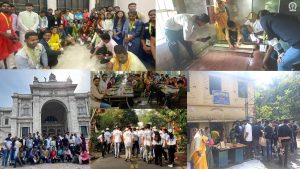
The team next started off its trip to Mayapur which is a neighbourhood of Bamanpukur, in the Nabadwip CD block in the Krishnanagar Sadar subdivision of the Nadia district, West Bengal, India. It’s situated at the confluence of the Jalangi River and the Bhagirathi, a tributary of the Ganges. They also visited Mogolmari, a village and an archaeological excavation site in the Dantan II CD block in the Kharagpur subdivision of the Paschim Medinipur district of West Bengal where the students explored the village life of West Bengal and got a first-hand experience of the basics of how agricultural land is prepared for ploughing. The next destination of the team was Sabang, where they learned the skill of hand-weaving of “Madur” (Mat) and met Mr. Dharnidhar Jana, also known as The Madur Man, who is also the recipient of Rashtrapati Puraskar from Talda Gram Sabang. The students were given a live demonstration on the Madur Mat Weaving process done at the Talda village, located in Sabang Subdivision of Paschim Medinipur district. The next destination was Bishnupur and Bakura where the students explored the unique articrafts and handicrafts of Bishnupur made with Terracotta which means ‘baked earth.’ It has been used to produce decorative art works as well as construction works since ancient times. All the heritage building in Bishnupur and Bakura contains encryption of these exclusive art forms. As an adieu from IIT KGP, a cultural night was organized by the Yuva Sangam team at IIT Kharagpur where the students and professors were engaged in a cultural exchange of soulful musical performances.
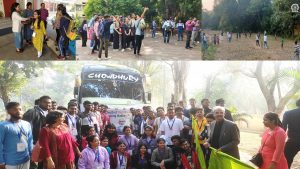
The team of Madhya Pradesh then embarked on their journey to Kolkata, the city of joy. After exploring richness of rural Bengal, they went to taste the flavours of Kolkata, the cultural capital of India. First the team went to Victoria Memorial which is a large marble monument dedicated to Queen Victoria, the Empress of India facing the Queens Way on the Maidan in Central Kolkata. It is the largest monument to a monarch anywhere in the world. It stands at 64 acres of gardens and is now a museum under the control of the Ministry of Culture, Government of India. Possessing prominent features of the Indo-Saracenic architecture, it has evolved into one of the most popular attractions in the city.
The next destination for the team was the visit to Dakshineswar temple which is a Hindu navaratna temple in Dakshineswar, Kolkata. Situated on the eastern bank of the Hooghly River, the presiding deity of the temple is Bhavatarini, a form of Parashakti Adya Kali, also known as Adishakti Kalika. The student then enjoyed the scenic beauty of Ganges through the ferry ride from Dakshineshwar temple to Belur Math and also had the famous prasad at the ISKON Temple in Kolkata. The entourage than visited Nawadip, a heritage city in Nadia district in the Indian state of West Bengal. It is regarded as a holy place by Hindus, and is the birthplace of Chaitanya Mahaprabhu. Finally the students concluded their journey by immersing their taste buds with the famous “Phucka” (Panipuri) of Kolkata and were blown away by its exquisite taste and texture. The team of IIT Kharagpur including Prof. Bharagb Maitra, Dean Student Affairs along with Prof. Chirodeep Bakli, Prof. Swati Maitra, Prof. Shuvro Prosun Sarker, Prof. Bharat Aithal, Prof. Manish Kaushal, Prof. Aritra Chatterjee, Prof. Sudeshna Koley, Prof. Gargi Gargate, Prof. Avishek Chatterjee, Prof. Suverna Trivedi and the entire team of Yuva Sangam at IIT Kharagpur, worked day and night to make Madhya Pradesh team’s experience a comfortable and enjoyable trip. Their hard work and dedication made this programme a grand and great success.
After the success of being a host, now it was time to be an Atithi to IIITDM Jabalpur. 50 students from the different universities of West Bengal were flagged off by Prof. V K Tewai, Director, IIT Kharagpur to explore Madhya Pradesh as a part of Yuva Sangam Phase III activity. The students learned about Bhil art from a young student in the railway station and explored places like Khajurahu, the Dhuadhar Falls, Maiyaar temple and also witnessed Narmada Aarti.
Under the aegis of Ek Bharat Shrestha Bharat – Yuva Sangam stood out as an example of cultivating the youth of this country so that they are aware of its origins, the country where he/she comes from and the country he/she will lead as the future stakeholders. Once called the “Golden Sparrow,” by the rest of the world, India shines with its beauty in diversity. Now emerging as the largest growing economy of the world, India upholds its rich legacy and cultural uniformity to establish the notion of Ek Bharat Shreshta Bharat by educating and upgrading the youth of this great nation through the platform of Yuva Sangam.
Takeaways:
- From the Ganges to the Dhuadhar: A Yuva Sangam Journey of Discovery shares Asirul Parwez, one of the students from the West Bengal Contingent to Madhya Pradesh
“Jabalpur, our gateway to Madhya Pradesh, embraced us with the warmth of its people and the aroma of its delectable street food. Our homestay, a traditional haveli with intricately carved arches and a courtyard bathed in moonlight, became our haven. Days were filled with exploration. We delved into the historical tapestry of Rani Durgavati’s fort, its ramparts whispering tales of valor. The marble splendor of the Teen Murti Temple, bathed in the golden glow of dawn, left us awestruck. And evenings were for exchanging stories, learning the rhythmic beats of Karma dances, and sharing laughter over steaming cups of chai. Our Yuva Sangam journey wasn’t just about sightseeing; it was about forging connections. We bonded with the locals, learning their dialects, savoring their culinary delights, and sharing stories that transcended cultural boundaries. We discovered the vibrancy of Jabalpur’s street markets, bargained for trinkets with mischievous smiles, and danced to the pulsating rhythm of dhol beats. Each interaction, each shared laugh, chipped away at the barriers of geography and language, weaving a tapestry of understanding. The Yuva Sangam experience was more than just a trip; it was a transformation. It broadened my horizons, challenged my preconceptions, and filled my heart with a newfound appreciation for the diverse tapestry of India. I returned not just with souvenirs and photographs, but with a suitcase brimming with memories, friendships, and a deeper understanding of my own nation. The echoes of the Dhuadhar falls, the warmth of Jabalpur’s hospitality, and the laughter of my newfound friends – these are the souvenirs I will cherish forever, a testament to the transformative power of Yuva Sangam,”
- Yuvaa Sangam Journey: A Cultural Odyssey from West Bengal to Madhya Pradesh says Pamit Dutta, one of the students from the West Bengal Contingent to Madhya Pradesh
“The journey commenced with a trip to Kharagpur, a city synonymous with academic excellence. From Kolkata to Kharagpur, the transition marked the beginning of our cultural sojourn, paving the way for the diverse experiences that awaited us. The train journey from Howrah to Kharagpur offered glimpses of the diverse landscapes of West Bengal. Passing through quaint villages and lush fields, the scenery painted a vivid picture of the varied beauty within the state. Reaching IIITDM Jabalpur was a continuation of our cultural odyssey. The hospitality extended by the institute and the warmth of the locals amplified the sense of belonging, reinforcing the idea that unity in diversity is the heartbeat of our nation. The stay in Jabalpur became a hub of cultural exchange. From traditional dance performances to interactive sessions, every moment was an opportunity to learn, connect, and celebrate the rich tapestry of Indian culture. A visit to Dhuadhar Falls brought about goosebumps as the cascading waters reflected the raw power and beauty of nature. The ropeway adventure, though at times both creepy and crazy, offered breathtaking views and a rush of adrenaline that added an adventurous twist to our cultural exploration. Navigating the ropeway presented a mix of emotions—creepy yet exhilarating, crazy yet awe-inspiring. It was a test of courage that, in retrospect, became a highlight of the trip, symbolizing the unexpected thrills that come with cultural exploration. In conclusion, the Yuvaa Sangam trip transcended its role as a government-organized cultural excursion. It became a chapter in my life filled with discovery, friendship, and a deeper appreciation for the diverse geography that makes India truly unique. The journey, from West Bengal to Madhya Pradesh, was a celebration of unity in diversity, leaving an indelible mark on my cultural consciousness.”
- Crossing Bridges : A Yuva Sangam Voyage from West Bengal to Madhya Pradesh remarks Sana Sajjad, one of the students from the West Bengal Contingent to Madhya Pradesh
“Each passing landscape was a brushstroke on our collective canvas. Emerald paddy fields gave way to ochre hills, villages painted in terracotta whispering tales of a different India. We learned about Bhil art from a young student on the platform, savored the tangy sweetness of “churma laddoos” offered by an elderly vendor, and danced to impromptu bhangra beats with a group of farmers. The train wasn’t just a mode of transportation; it was a microcosm of India, an ever-changing tapestry woven with laughter, shared stories, and the unspoken language of human connection. Jabalpur, our destination, embraced us with the warmth of a long-lost family. The local university became our home, bustling with activity and bonhomie. Days were filled with explorations; mornings painting our senses with the aroma of spicy jalebis and the echoing chants from an ancient temple, afternoons lost in the labyrinthine corridors of the Rani Durgavati museum, and evenings echoing with impromptu poetry readings and bonfire singalongs. But the most valuable souvenir we brought back was a renewed understanding of India. It wasn’t just about the majestic waterfalls, the intricate temples, or the spicy food. It was about the people we met, the stories we shared, the laughter that echoed across borders and boundaries. We returned to West Bengal carrying within us a piece of Madhya Pradesh, a newfound appreciation for diversity, and a heart brimming with stories waiting to be told.”
- Yuvaa Sangam: A Transcendent Journey from West Bengal to Madhya Pradesh mentions Subhankar Sarkar, one of the students from the West Bengal Contingent to Madhya Pradesh
“Setting off on the Yuvaa Sangam pilgrimage from the verdant regions of West Bengal to the bustling metropolis of Madhya Pradesh was an experience that went beyond simple travel. It was a voyage of self-discovery, cultural absorption, and establishing enduring relationships. My family’s excitement and eagerness were evident as soon as I learned about this thrilling journey, laying the groundwork for an amazing time. Once we arrived in Madhya Pradesh, the surrounding landscapes opened up like pages from a travelogue. My experiences were painted on canvases by the architectural magnificence of Khajuraho, the spiritual vibes of Maihar, and the historical richness of Chitrakoot. Every location made a lasting impression and added to the mosaic of recollections that characterized the Yuva Sangam tour. I realize that the Yuva Sangam trek from West Bengal to Madhya Pradesh was more than just a travel experience; it was a life-changing adventure that enhanced the fabric of my being. It was an ode to the friendships made with other travelers as well as a celebration of diversity and a dance of cultures. The memories I made on this voyage are chapters in a book of my personal development, not merely moments captured in time. The Yuva Sangam excursion left a lasting impression on my psyche, serving as a symbolic bridge that connected the East and the heart of India.”
Media Coverage:
| PTI | Times of India | Statesman |
| PIB | India Today | The Week |
| Humming Birds | Amader Bharat | KGP News |

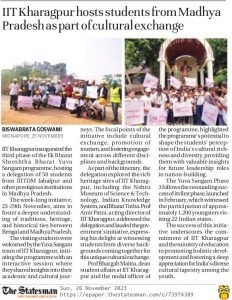
Times of India The Statesman
By : Poulami Mondal, Digital & Creative Media Executive (Creative Writer)
Email: poulami.mondal@iitkgp.ac.in, media@iitkgp.ac.in, Ph. No.: +91-3222-282007
Follow us: Facebook – IIT Kharagpur; Twitter – @IITKgp; Instagram – @iit.kgp; LinkedIn – Indian Institute of Technology
For news visit: https://kgpchronicle.iitkgp.ac.in/

